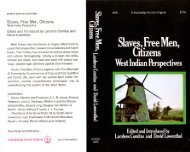e - CIFAS
e - CIFAS
e - CIFAS
You also want an ePaper? Increase the reach of your titles
YUMPU automatically turns print PDFs into web optimized ePapers that Google loves.
.. GOVERNMENT IN ZAZZAU<br />
ways, Q)otained Yacious structural checks and balances which were<br />
of value in promoting and maintaining the equilibrium of the<br />
system; and thereby in ensuring its continuity. Apart from their<br />
functional differentiation in terms of military and civil interest?<br />
offices were also differentiated in terms of their political and ad~<br />
ministrative significance at Abuja, and this differentiation was re~<br />
lated to the variable composition ofsegmentary political groupings.<br />
The interest and constitution of these contraposed groupings<br />
altered according to the context or issue, while the segments themselves<br />
reflected certain pervasive principles, namely, the rank~<br />
ordering of offices, the distribution of office according to status<br />
conditions, their promotional organization, economic differentiation,<br />
and the like. The presence of administrative agencies specialized<br />
to co-ordinate these contraposed units and to maintain the<br />
minimal conditions essential for the order and unity of the system<br />
as a whole is correlated withthis variability ofpolitical segmentation<br />
at Abuja. Whether the operation of multiple principles of alignment<br />
and conrraposition precedes the development of specialized<br />
administrative agencies cannot be stated, either for Abuja or in<br />
general. Probably, the two developments are functionally related,<br />
and probably the multiplication of principles of alignment is<br />
initially associated with the growth of politically significant<br />
differences of status, especially hereditary differences.<br />
(b) The System ojPolitical Relations<br />
In the general discussion of government, political action was<br />
defined by its focus on policy, and by its segmentary process and<br />
form. These segmentary processes were further defined by conditions<br />
of variability in the comPQsition of contraposed units; and<br />
this variability is limited on the one hand by the range of issues,<br />
and on the other by the basic principles of the particular social<br />
structure. From this, it follows that the operation of segmentary<br />
principles defines the field of political relations, and also that the<br />
differentiation ofadministrative action is associated with the opera~<br />
tion of an increasing number of segmentary principles as criteria<br />
for the composition of contraposed political groups. This increase<br />
in the number of segmentary principles considerably increases the<br />
variability of political groupings, with the consequence that<br />
specialized agencies committed to maintain the minimal conditions<br />
of order and unity are necessary if the system is to persist. These<br />
GOVERNMENT IN NINETEENTH-CENTURY ABUJA 49<br />
general ideas can be applied usefully to the organization of<br />
government at Abuja.<br />
At Abuja, the principal field of political relations was constintted<br />
by the king, the household officials, and the two orders of public<br />
officials, namely the Tukuni and the rawuna. The chamber officials<br />
were marginal to this structure, although they were indirectly<br />
linked to it, as they supplied holders of the offices of Galadima,<br />
Wambai, and Dallatu. On the information at our disposal, it is<br />
difficult to see how either the maUams, the dynasty, the royal<br />
officials or the order of titled slaves could enter into contraposition<br />
with one another, or with either of these previously mentioned<br />
groups. The chamber officials, despite their prospects ofpromotion<br />
to rukuni eunuch offices, must also be regarded as a subordinate<br />
administrative staff, the main functions ofwhich were cornmunica·<br />
tions, care of the treasury, the insignia, the royal harem, and the<br />
king. The king was head of both the political and the administra·<br />
tive systems, controlling the latter directly, hut not the former; and<br />
he was probably preoccupied with problems of co-ordination and<br />
equilibrium, rather than with the personal direction ofthe govern·<br />
ment as a whole. In other words, the monarchy was limited in its<br />
power, simply by virtue of its participation in a system of seg·<br />
mentary political relations with the orders of public and household<br />
officials. In this situation, neither the king nor his political part~<br />
ners had the decisive voice in selecting his successor.<br />
Although political issues mobilized political groups at Ahuja, the<br />
variety of segmentary principles at work in the official orders ensured<br />
that the composition of these groupings would vary according<br />
to the issue. One reason for such variability lay in the fact that<br />
the principles in terms ofwhich contraposed groups were organized<br />
were not all of the same order. For example, together the rukuni<br />
and the r4WUna formed a single inclusive group of public officials<br />
which was distinguished structurally and functionally from the<br />
inclusive group of palace personnel, namely, the household<br />
officials and chamber eunuchs. Unlike these two latter orders, the<br />
rukuni and rowuna administered territorial fiefs. The household<br />
officials were dependent on the king for reward; and the chamber<br />
eunuchs were also partly dependent on the king, although, in their<br />
capacity as messengers to the vassal chiefs and the other official<br />
orders, they enjoyed certain benefices. Their lack of salary or any<br />
specified means ofofficial reward distinguished the order of house-





